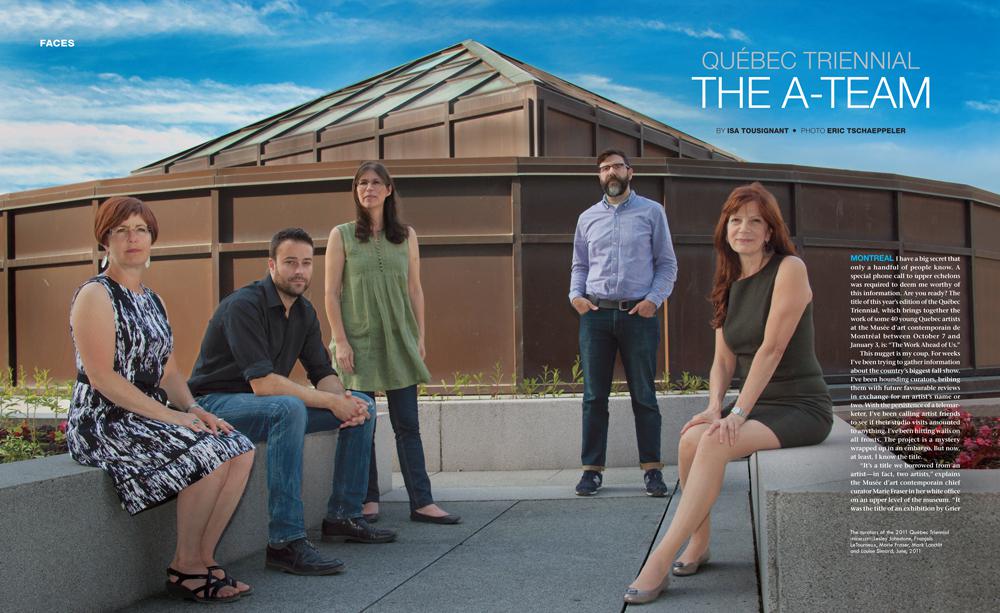MONTREAL I have a big secret that only a handful of people know. A special phone call to upper echelons was required to deem me worthy of this information. Are you ready? The title of this year’s edition of the Québec Triennial, which brings together the work of some 40 young Quebec artists at the Musée d’art contemporain de Montréal between October 7 and January 3, is: “The Work Ahead of Us.”
This nugget is my coup. For weeks I’ve been trying to gather information about the country’s biggest fall show. I’ve been hounding curators, bribing them with future favourable reviews in exchange for an artist’s name or two. With the persistence of a telemarketer, I’ve been calling artist friends to see if their studio visits amounted to anything. I’ve been hitting walls on all fronts. The project is a mystery wrapped up in an embargo. But now, at least, I know the title.
“It’s a title we borrowed from an artist—in fact, two artists,” explains the Musée d’art contemporain chief curator Marie Fraser in her white office on an upper level of the museum. “It was the title of an exhibition by Grier Edmundson at the Montreal gallery Battat Contemporary, and he’d taken it from a text by Vladimir Tatlin from the 1920s. For us, the idea of ‘the work ahead of us’ became really significant as we began work on the triennial. When we started this project, the idea was to create a reference book on Quebec art in the last ten years. As soon as we began the fieldwork, we realized what an incredible job it was going to be. So we thought we’d flip the concept a little, and with the publication we’d take a look at the past and where it’s brought us, while with the exhibition we’ll look at the present through the lens of the work that’s ahead of us in the future.”
With the first edition of the triennial in 2008, the museum surprised the Quebec art scene with a loving homage. The show brought together 40 midcareer artists and, though there was some critical grumbling, most agreed that the selection was good and that the show was an edifying experience. This time, that precedent looms large. Every Quebec artist and her brother has been waiting for the last three years to get some time in the sun of the new show. It’s a monstrous responsibility for the five people curating it.
The team is composed of Marie Fraser, who, while relatively new to the museum, is deeply anchored in the province’s contemporary art scene; Lesley Johnstone, an integral part of the first triennial; Mark Lanctôt, another key player in the last edition; François LeTourneux, the fresh blood; and finally, Louise Simard, a voice of authority on multimedia art. The way I picture it, they travel the province together, going from one studio to another like rock stars on a tour bus—or school kids on a minibus.
“I guess we’d have done that if it had been possible,” laughs Fraser, noting that the team visited nearly 100 studios. “It wasn’t always easy to get us all together. We would always go at least by two or three together, though.
“As much as we make it our duty to see graduation exhibitions and to participate on juries, it’s still very rare for us to get such a wide impression of new Quebec art production. We always tried to tell the artists we visited that even if they weren’t selected for the triennial, we’ll be working on all the stuff we saw for years to come. For years and years! We saw so many young artists.”
Were they taken by surprise?
“Yes, we had a big surprise. A real surprise. We had so many lists of artists at one point, we just didn’t know how we’d manage it. Then we took a moment and said, ‘Let’s try to see what fits together.’ We saw how important performance and performativity were, so we decided to push that idea a bit further to make it stand out. There are artists who inspire themselves from the work of other artists. There’s the whole question of re-enactment, for example, which is also, for me, a performative act. The relationship of the artist to his public and the public to his work was also very present. There are artists who require a certain form of participation from their viewer that relates to the passage of time, for example. Sound also stood out as an important element. So, yes, we made quite a few discoveries.”
Enter the Triennial Live. In addition to the museum’s eight exhibition galleries, a portion of the exhibition will animate the museum and beyond every Wednesday night with a cutting-edge performance program. The curators are exploring new spaces in the widest possible sense and taking advantage of the outdoor Grand Foyer Culturel de la Place des Arts and Place des Festivals, where hundreds of passersby make their way to and from the metro every day. In Fraser’s words, “we wanted the museum to really become a destination. To be a very, very animated place.”
Excitement is mounting for a big, boastful celebration of the best of la belle province, and I point out to Fraser that as soon as the new edition’s done, there will be the next one to begin.
“I know!” she says. “While we were doing the fieldwork, we realized how endless the possibilities are. Artists renew themselves continuously. There will always be material out there to fill the Québec Triennial. Always.”
This is an article from the Fall 2011 issue of Canadian Art. To read more from this issue, please visit its table of contents.

 Spread from the Fall 2011 issue of Canadian Art / photo Eric Tschaeppeler
Spread from the Fall 2011 issue of Canadian Art / photo Eric Tschaeppeler







